
Case Report
Austin Oncol Case Rep. 2023; 6(1): 1018.
Diplopia and Bone Marrow Failure as Initial Presentation of Breast Cancer: A Case Report
Tarek Khrisat; Abdelrahman Habiba; Sydney G McCalla*
Department of General Surgery, Lincoln Medical Center, USA
*Corresponding author: Sydney G McCalla Department of Surgery, Suite 620, Lincoln Medical Center 234 East 149th St., Bronx, NY 10451, USA. Email: tarekkhrisat@gmail.com
Received: March 28, 2023 Accepted: April 27, 2023 Published: May 04, 2023
Abstract
This is a 47-year-old woman who presented to the Emergency room with acute onset of right eye diplopia and drooping of the eyelid associated with fatigue. On further examination, patient noted to have a large fungating right breast mass, reportedly been rapidly growing for the past few months. Also, patient found to have pancytopenia with multiple bony metastases.
This is an interesting case that presents some of the rare metastatic patterns of breast cancer, which can include the orbit, and hematologic abnormalities due to spinal mets. Breast cancer is reported to be responsible for most ophthalmic mets, with it being the primary neoplasms of origin of 40% of the metastases to the orbit.
Keywords: Orbital mets; Pancytopenia; Fungating mass; Breast cancer
Case Report
A 47-year-old woman presented to the Emergency Department with complaints of acute onset right eye diplopia and drooping of the eyelid for the past 3 days. She denied any headache or focal neurological deficits. On further history taking, the patient reported a rapidly growing right breast mass of a few months' duration. Clinical examination revealed hyperemia with exophthalmos and drooping of the right eyelid, bilateral retinal hemorrhages, and an 8x11cm upper outer quadrant fungating right breast mass (Figure 1) with palpable axillary adenopathy. Labs were significant for severe thrombocytopenia with a platelet count of 34x10(3)/mcL.

Figure 1: Fungating Breast mass.
CT imaging revealed multiple bilateral intraorbital soft tissue masses within the extraocular muscles (Figure 2), multiple scalp soft tissue masses, lytic osseous lesions in the calvarium and skull base, numerous bilateral pulmonary nodules (Figure 3), thoracic adenopathy, and spinal sclerotic metastases (Figure 4).
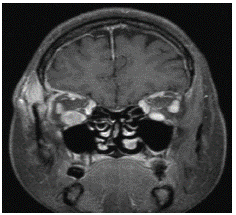
Figure 2: Intraorbital mets.
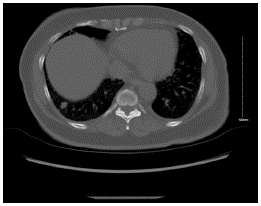
Figure 3: Pulmonary nodules.

Figure 4: Sclerotic spinal mets.
Breast surgery was consulted to evaluate the patient for the concerning clinical exam and imaging findings. A follow up breast sonogram and mammogram showed a large dense mass in the upper outer quadrant of the right breast (Figure 5) and several small nodules in the left breast (Figure 6). A core needle biopsy was obtained from the mass, and pathology demonstrated grade II infiltrating ductal carcinoma ER/PR+ HER2- (Figure 7).
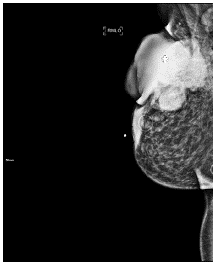
Figure 5: Right breast mass.
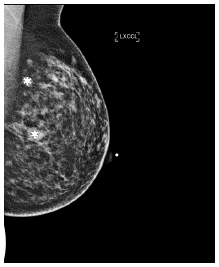
Figure 6: Multiple Left breast masses.
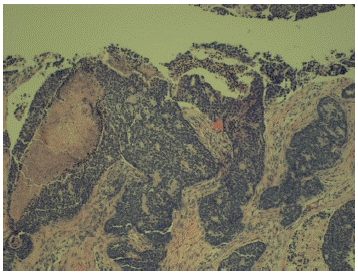
Figure 7: Right breast biopsy.
Invasive ductal carcinoma with necrosis, Nottingham Histologic score 7 of 9, grade 2 of 3 (Hematoxylin-Eosin, original magnificationx100)
Discussion
We report a rare case of advanced metastatic breast cancer with rare involvement of the orbit and the bone marrow. Overall Ophthalmic Metastases (OM) affects approximately 2–5% of patients with systemic malignancies. Breast, melanoma, and prostate cancers comprise the prevalent primary tumors. With breast cancer being the primary neoplasms of origin of 40% of the metastases to the orbit [1]. In contrast to other orbital metastases, breast carcinoma can have a bilateral presentation in up to 15-20% of cases [2]. Due to a tissue-specific preference of breast cancer to extra-ocular muscle and surrounding orbital fat, diplopia resulting from mobility deficits is a prevalent symptom. Other common symptoms and signs include proptosis, eyelid swelling, pain, palpebral ptosis, and blurred vision, caused by infiltration or compression [5].
Orbital metastases originating from breast carcinoma predicts widespread metastatic disease in other organs. Patients require a systemic workup to evaluate for metastases to other organ systems, and a multidisciplinary team including oncology, radiation oncology, and ophthalmology are necessary. External beam radiotherapy to stabilize the orbital metastatic lesion is the mainstay therapy, usually administered to control tumor growth, preserve visual function in the short term, decrease proptosis and exposure keratopathy, or to improve patient comfort [4].
Furthermore, bone marrow infiltration with metastatic breast cancer was the primary cause of pancytopenia in this case. Although bone marrow infiltration by metastases is commonly present among breast cancer patients, total bone marrow infiltration resulting in profound thrombocytopenia is extremely rare. There have been few reports on patients with metastatic breast cancer with symptomatic Bone Marrow Metastases (BMM). Anemia was the most common symptom, with 40%-60% of patients with BMM having a hemoglobin level of less than 12g/dL. Thrombocytopenia, leukocytopenia, or both have been reported in only 12%-25% of patients with aberrant bone marrow results. In our case, the patient developed complete bone marrow infiltration by estrogen receptor-positive metastatic breast cancer that led to transfusion-dependent pancytopenia [3].
Conclusion
We provide a rare presentation of breast cancer with visual impairment and bone marrow failure due to infiltration by estrogen receptor-positive metastatic breast cancer that led to transfusion-dependent pancytopenia and visual impairment. Management of such advanced disease requires multidisciplinary team evaluation and combination of radio and chemotherapy.
References
- Blohmer M, Zhu L, Atkinson JM, Beriwal S, Rodríguez-López JL, et al. Patient treatment and outcome after breast cancer orbital and periorbital metastases: a comprehensive case series including analysis of lobular versus ductal tumor histology. Breast Cancer Res. 2020; 22: 70.
- Vlachostergios PJ, Voutsadakis IA, Papandreou CN. Orbital Metastasis of Breast Carcinoma. Breast Cancer: Basic and Clinical Research. 2009; 3.
- Gaurav Pahouja, Robert Wesolowski, Raquel Reinbolt, Gary Tozbikian, Michael Berger, et al. Lustberg, Stabilization of bone marrow infiltration by metastatic breast cancer with continuous doxorubicin. Cancer Treatment Communications. 2015; 3: 28-32.
- Palmisciano P, Ferini G, Ogasawara C, Wahood W, Bin Alamer O, et al. Orbital Metastases: A Systematic Review of Clinical Characteristics, Management Strategies, and Treatment Outcomes. Cancers (Basel). 2021; 14: 94.
- Michael T Yen, Marcus M Marcet, Dalia Girgis, Cat Nguyen Burkat. Breast Carcinoma Metastatic to the Orbit, UpToDate.